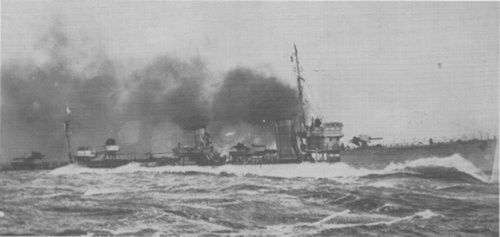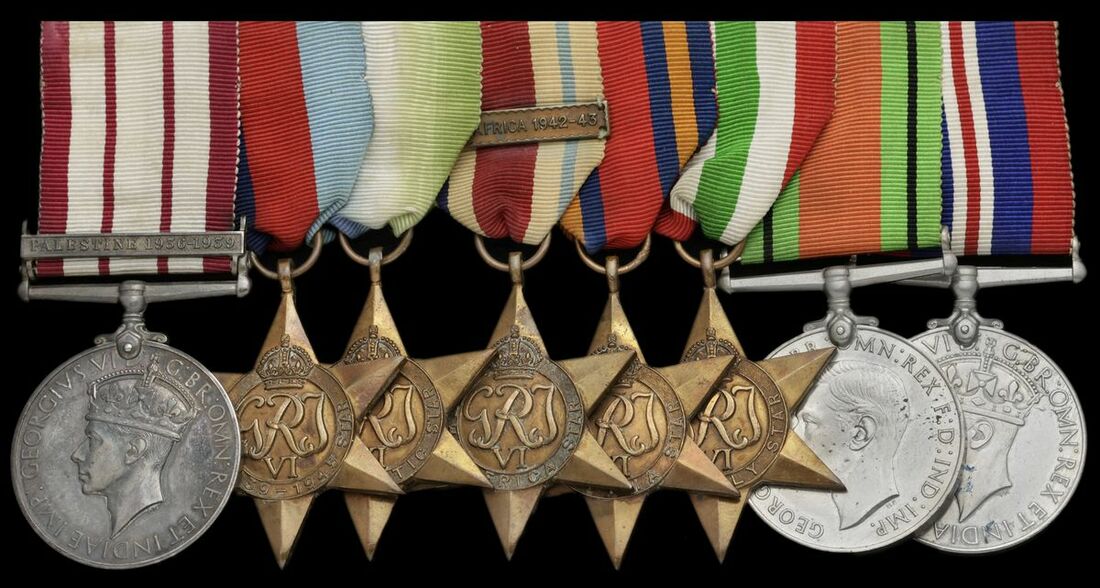Auction: 23001 - Orders, Decorations and Medals
Lot: 160
Eight: Lieutenant-Commander L. D. B. Kenny, Royal Navy, who survived the sinking of H.M.S. Thanet, being lucky to escape ashore as all those who were captured by the Japanese Navy were handed over to the Army and subsequently massacred on 31 January 1941
Naval General Service 1915-62, 1 clasp, Palestine 1936-39 (Lt. L. D. B. Kenny. R.N.); 1939-45 Star; Atlantic Star; Africa Star, clasp, North Africa 1942-43; Burma Star; Italy Star; Defence and War Medals 1939-45, mounted as worn, minor pitting, very fine (8)
Lionel Desmond Bryan Kenny was born at Plymouth on 24 September 1911, the son of Lillian and Surgeon-Captain Edward Kenny, Royal Navy. Entering the Royal Navy as a Cadet on 1 January 1929 and commissioned Midshipman on 9 September 1929, his first posting was to the battleship Emperor of India. He served aboard a number of vessels including Tiger and Malaya before attending a course at the Royal Naval College, Greenwich and, on its completion, being promoted Sub-Lieutenant on 1 September 1939. Assigned to the destroyer Crescent and later the cruiser Delhi Kenny was further advanced Lieutenant with her on 1 September 1934. Still with Delhi, Kenny saw service off the coast of Palestine (Medal & clasp).
Promoted 1st Lieutenant on H.M.S. Wanderer, Kenny was in this rank on the outbreak of the Second World War while aboard the S-Class destroyer Thanet on the China Station. She remained 'out East' after the declaration of war with the intention of intercepting German shipping in the region and was still there when the Japanese declared war on Britain. As the need for warships in the East had now increased, Thanet was transferred to Singapore where she began to undertake escort duties.
Paired with the Australian destroyer H.M.A.S. Vampire, she was given orders to intercept a Japanese invasion force believed to be headed for Malaya. However when Thanet and her consort headed towards the Japanese ships off Endau on 26 January 1942 they discovered that their intelligence had been wrong: rather than an exposed transport fleet they were opposed by a powerful squadron of warships led by the cruiser Sendari backed by three destroyers.
The Japanese vessels opened up on the outnumbered Allied ships and quickly bracketed Thanet with a heavy fire, focusing upon her at the expense of allowing Vampire to escape under cover of smoke. Without the support of her consort and massively outgunned, Thanet was soon in dire straits with her engine room taking a heavy hit. Lieutenant-Commander Bernard Davies saw that his ship was doomed and aimed for the shore, managing despite all the odds and still under heavy fire to beach her. One officer and 30 ratings from Thanet had either abandoned ship or been thrown into the water and they were picked up by the Sendari. A further five officers - including Davies and Kenny - escaped overland with 61 ratings and members of an aircraft they had rescued after a ditching. They were the lucky ones - those men plucked from the water were handed over to the Japanese Army and never heard from again; it is believed that they were executed in revenge for Japanese losses during the Battle for Malaya.
After a truly gruelling 100-mile trek through the jungle, the crew made it to Singapore and from there they were shipped home - fortunately escaping the horrors of the siege and fall of that city, which was yet to come. It is not hard to imagine that Kenny must have breathed a sigh of relief upon leaving the East, not knowing how much hard fighting still lay ahead of him. Next posted to the cruiser Sirius in August 1942, that same month she took part in Operation Pedestal, the effort on the part of Force Z to push a convoy of supply ships through the Axis forces blockading Malta.
Leaving Gibraltar on 10 August 1942 the task force soon came under heavy attack by a mixed force of aircraft, submarines and torpedo boats. Six transports made it through - however the losses were high with the carrier Eagle, cruiser Manchester and destroyer Foresight also being lost. Most, if not all, of the escorts suffered damage and Sirius was no exception. Kenny must have performed admirably as he was soon promoted Lieutenant-Commander, on 1 September 1942.
Assigned ashore to Cormorant and later Royal Arthur, Kenny was soon to return to sea aboard the escort carrier Stalker which he joined on 17 December 1942. Taking part in operations in the Aegean with her - intended to isolate the German garrisons there in order to allow Allied offensives in the area - later he was to head East again with her as part of the British force assembling to invade and retake Singapore.
Remaining in the Royal Navy after the end of hostilities, his next posting was at the shore establishment at Scotia, a signal training school. Next sent to the cruiser Birmingham, as Executive Officer, Kenny was aboard her between August 1948-May 1950. Finally retiring on 24 September 1956 from the base Pembroke, Chatham, he joined the Inland Revenue and additionally became verger of his local church. Making his home in central London, he died there as a result of a heart attack on 1 December 1977; sold together with a typed biographical note along with copied research including a London Gazette extract, Navy Lists and copied service record as well as histories of H.M.S. Thanet, Sirius and Stalker.
Subject to 20% VAT on Buyer’s Premium. For more information please view Terms and Conditions for Buyers.
Sold for
£230
Starting price
£170







